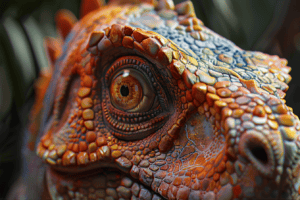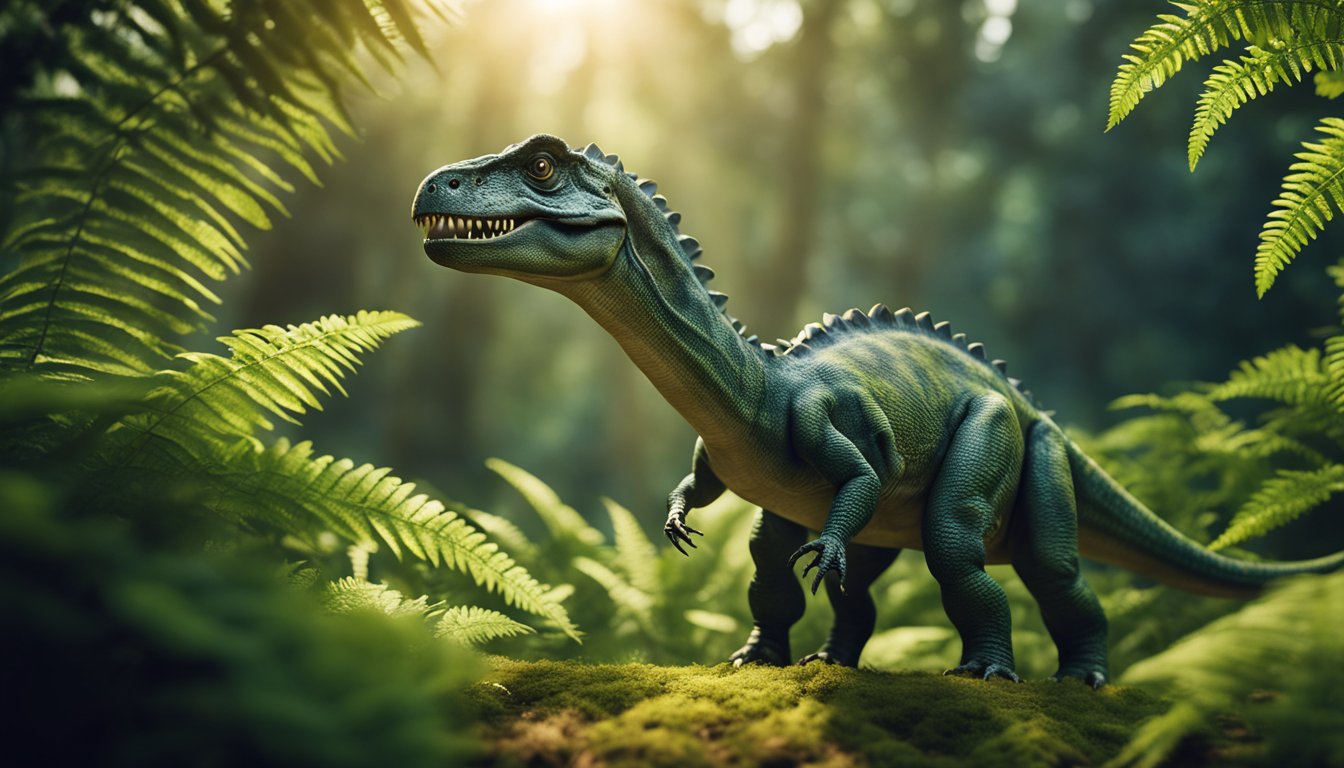Deinocheirus, the dinosaur with giant arms, is a fascinating creature that has captured the imagination of scientists and the public alike.
Discovered in Mongolia in 1965, Deinocheirus was initially known only from a pair of enormous arms with sharp claws, which earned it the name “terrible hand”.
For decades, the rest of the dinosaur remained a mystery, until new fossils were uncovered that revealed its true size and appearance.

At over 10 meters in length, Deinocheirus was a massive theropod dinosaur that lived during the Late Cretaceous period, around 70-66 million years ago.
Its most distinctive feature was its huge arms, which measured over 2 meters in length and were tipped with sharp, curved claws.
Scientists believe that these arms were used for a variety of purposes, including grasping vegetation, hunting prey, and defending against predators.
Despite its fearsome appearance, Deinocheirus was likely an omnivore, feeding on both plants and animals.
Thanks to new research and discoveries, we now have a better understanding of Deinocheirus and its place in the dinosaur family tree.
This dinosaur’s giant arms and unusual appearance have made it a popular subject of study and speculation, and there is still much to learn about this enigmatic creature.
In this article, we will explore the fascinating world of Deinocheirus, from its discovery to its role in the ecosystem of the Late Cretaceous period.
Unearthing the Giant: The Discovery of Deinocheirus

The First Fossil Fragments
Deinocheirus was a dinosaur that remained a mystery for over four decades.
The first fossil fragments of Deinocheirus were discovered in the Gobi Desert of Mongolia in 1965 by a Polish-Mongolian Palaeontological Expedition.
The fossils consisted of two long arms with scapulocoracoids, which measured 2.4 meters in length.
These fossils were so unique that they were difficult to classify, and for years, researchers could not determine which dinosaur they belonged to.
Piecing Together the Puzzle
It wasn’t until 2014 that paleontologists were able to solve the mystery of Deinocheirus.
Researchers, including Zofia Kielan-Jaworowska and Yuoung-Nam Lee, pieced together the puzzle by studying two new specimens of Deinocheirus discovered in the Nemegt Formation of Altan Uul IV in 2006 and Bugiin Tsav in 2009.
These new specimens had many unique skeletal features that were unknown in other ornithomimosaurs, indicating that Deinocheirus was a heavily built, non-cursorial animal.
By studying these new specimens and comparing them to the original fossils, researchers were able to reconstruct the entire skeleton of Deinocheirus.
They discovered that Deinocheirus was a massive dinosaur that measured up to 11 meters in length and weighed an estimated 6.4 tons.
The discovery of Deinocheirus was a significant breakthrough in the field of paleontology.
It provided researchers with new insights into the Late Cretaceous period and the evolution of dinosaurs.
Today, Deinocheirus remains one of the most fascinating dinosaurs to have ever lived, and researchers continue to study this incredible animal to learn more about its behavior, habitat, and lifestyle.
Fun Fact: Deinocheirus means “terrible hand” in Greek, which refers to its massive forelimbs.
The Mystifying Anatomy of Deinocheirus
Deinocheirus is a bizarre and unusual dinosaur known for its unique anatomy.
Its remarkable body has mystified scientists for decades, and it wasn’t until recently that new discoveries shed light on its true nature.
Arms and Claws: Tools for Survival
Deinocheirus is famous for its giant arms and enormous claws. Its arms were over eight feet long, and its claws were almost a foot in length.
These tools were essential for survival, allowing the dinosaur to catch prey and defend itself from predators.
The claws were curved and razor-sharp, perfect for tearing into flesh.
The arms were also incredibly strong, allowing Deinocheirus to overpower even the largest of prey.
Scientists believe that Deinocheirus was a theropod, a type of dinosaur that was known for its sharp claws and powerful arms.
The Rest of the Remarkable Body
Deinocheirus was not just known for its arms and claws. Its entire body was bizarre and unusual, with features that set it apart from other dinosaurs.
For example, it had a hump on its back, supported by its back bones, which was unique among dinosaurs.
It also had a bill-like mouth, similar to that of a duck-billed dinosaur.
Deinocheirus was an ornithomimosaur, a group of dinosaurs that were known for their ostrich-like appearance.
However, Deinocheirus was much larger than other ornithomimosaurs, with a body that was over 35 feet long.
Its legs and feet were also massive, allowing it to run at incredible speeds.
Despite its bizarre appearance, Deinocheirus was a successful predator that lived alongside other dinosaurs like sauropods and other theropods.
Its unusual anatomy allowed it to thrive in a world full of danger and competition.
Fun Fact: Scientists have found gastroliths, or stomach stones, in the fossilized remains of Deinocheirus.
These stones were used to help grind up tough plant material in the dinosaur’s stomach.
Deinocheirus’s Lifestyle: Understanding Behaviors and Habitat

Dining Habits: An Omnivore’s Diet
Deinocheirus was a large, hump-backed dinosaur that roamed the Earth during the Late Cretaceous period.
It was an omnivore, which means it ate both plants and animals. Its diet included fish, herbaceous plants, and possibly even small animals.
Deinocheirus had a unique set of teeth that were perfect for its omnivorous diet.
Its front teeth were flat and broad, which allowed it to grind up tough plant material.
Its back teeth, on the other hand, were sharp and pointed, which helped it to tear through the scales of fish and other animals.
Adapting to the Environment
Deinocheirus lived in the Gobi Desert, which is located in present-day Mongolia.
The desert was a harsh environment, with little vegetation and extreme temperatures.
Deinocheirus adapted to this environment by developing several behaviors that allowed it to survive.
One of the ways Deinocheirus adapted to its environment was by gathering food. It used its long arms to reach up and pluck leaves from trees and shrubs.
It also used its arms to dig up roots and tubers from the ground. This behavior allowed it to supplement its diet with nutrient-rich plant material.
Deinocheirus also had a unique way of catching fish.
It would wade into shallow streams and use its long arms to scoop up fish from the water.
It would then use its sharp teeth to tear through the fish scales and eat the meat inside.
Despite its large size, Deinocheirus was not at the top of the food chain.
It had several predators, including other dinosaurs and possibly even early mammals.
To protect itself, Deinocheirus had a tough, scaly skin that acted as armor. This skin was made up of small, bony plates that were embedded in the skin.
Deinocheirus’s habitat was also an important factor in its survival.
It lived in areas with sandstone formations, which provided shelter from the harsh desert environment.
These formations also provided a source of water, which was essential for the survival of both Deinocheirus and its prey.
Fun Fact: Deinocheirus was one of the largest dinosaurs of its time, weighing up to 7 tons!
Threats to Deinocheirus: From Predators to Poachers

Natural Enemies and Survival
As a large and powerful dinosaur, Deinocheirus likely had few natural predators.
However, it is possible that it may have been hunted by other large theropods such as Tyrannosaurus Rex or Tarbosaurus.
Despite this, Deinocheirus was able to survive and thrive for millions of years.
The Modern Menace: Fossil Poaching
Unfortunately, Deinocheirus faces a new threat in the modern world – fossil poaching.
Fossil poachers illegally excavate fossils from protected areas, often destroying important scientific information in the process.
The Mongolian government and international research teams have been working to combat this issue, but it remains a significant problem.
The Museum of Natural History in Mongolia was the site of a major fossil poaching incident in 2012, where nearly 80 Deinocheirus specimens were stolen from the museum’s collection.
These specimens were taken from a Mongolian quarry and were intended to be sold on the black market.
Fossil poaching not only harms scientific research but also robs the public of the opportunity to learn about and appreciate the natural world.
It is important to protect fossils and the natural environment in which they are found.
Deinocheirus is a fascinating dinosaur that has captured the imagination of scientists and the public alike.
By protecting fossils and the natural world, we can continue to learn about and appreciate the amazing creatures that once roamed the earth.
Frequently Asked Questions

What unique features did Deinocheirus have compared to other dinosaurs?
Deinocheirus was a dinosaur with a unique set of features that set it apart from other dinosaurs.
It had a hump on its back, a long tail, and a duck-like bill. However, its most distinctive feature was its giant arms.
These arms were almost 8 feet long and ended in three-fingered hands that were tipped with long, sharp claws.
How did scientists eventually solve the mystery of Deinocheirus?
For many years, scientists only had the arms of Deinocheirus to study. They had no idea what the rest of the dinosaur looked like.
It wasn’t until 2014 that a nearly complete skeleton was discovered in Mongolia.
By studying the bones, scientists were able to piece together what Deinocheirus looked like and how it lived.
What can the giant arms of Deinocheirus tell us about its lifestyle and behavior?
The giant arms of Deinocheirus suggest that it was a predator. However, it likely didn’t hunt with its claws.
Instead, scientists believe that it may have used its long arms to reach vegetation that was out of reach for other dinosaurs.
Its claws may have been used for self-defense or to help it climb steep slopes.
In what ways did the discovery of the full Deinocheirus skeleton change previous theories?
The discovery of the full Deinocheirus skeleton helped to dispel many myths about the dinosaur.
Previously, scientists believed that Deinocheirus was a slow, lumbering dinosaur that lived in water.
However, the discovery of the full skeleton showed that Deinocheirus was actually a fast-moving, bipedal dinosaur that lived on land.
How does the size of Deinocheirus compare to other well-known dinosaurs?
Deinocheirus was a large dinosaur, but it wasn’t the largest. It was about 30 feet long and weighed around 6 tons.
For comparison, the Tyrannosaurus Rex was about 40 feet long and weighed around 7 tons.
What habitats did Deinocheirus live in during its existence?
Deinocheirus lived in what is now Mongolia during the Late Cretaceous period, about 70 million years ago.
At that time, the area was covered in forests and had a warm, humid climate.
Deinocheirus likely lived near rivers and lakes, where it could find food and water.







